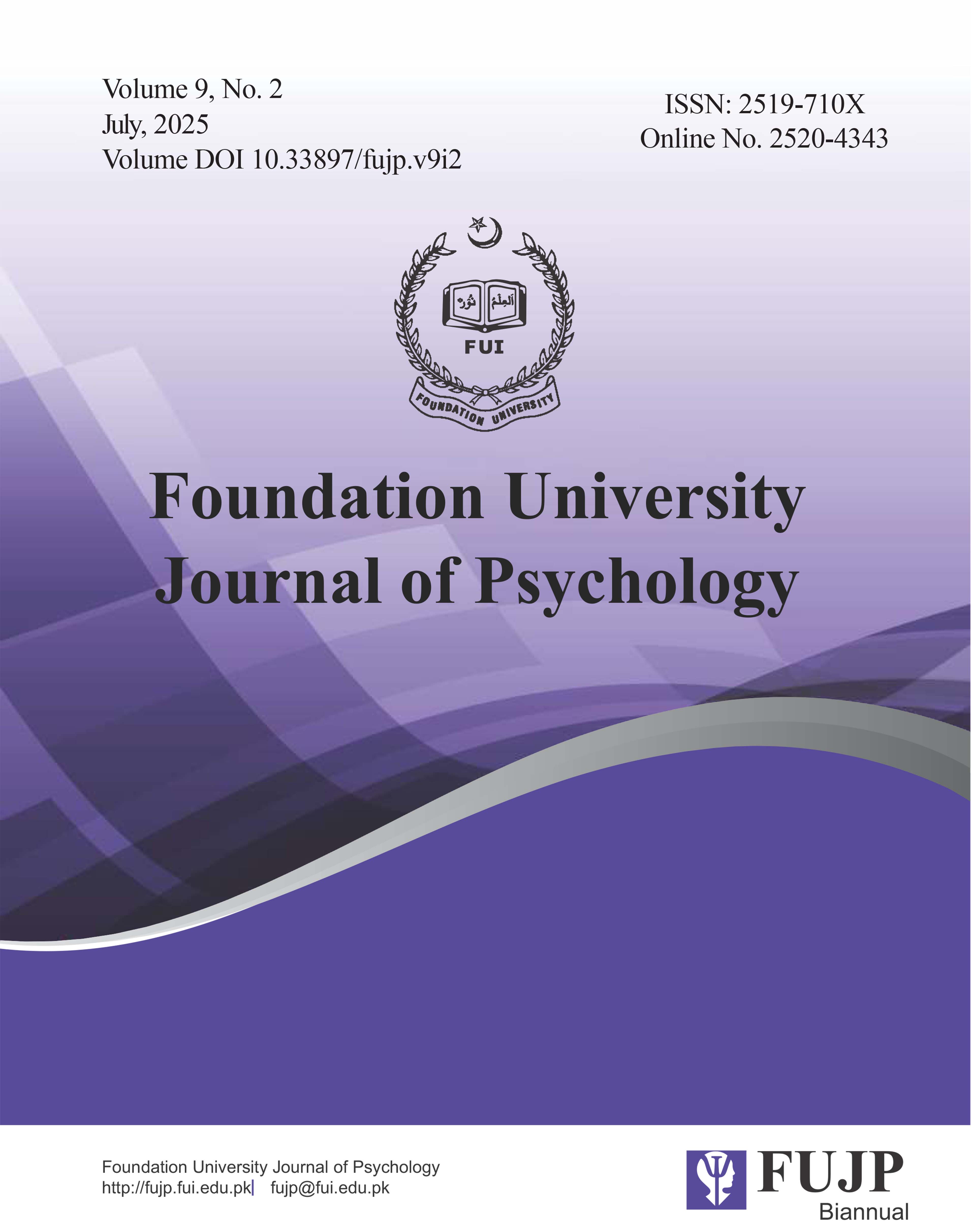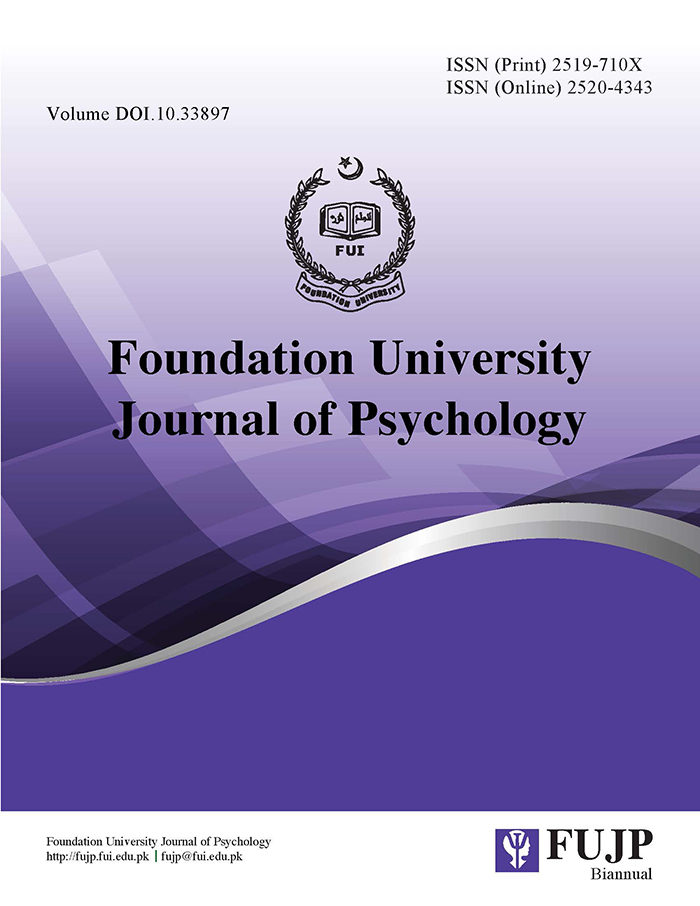Gender Difference across Diabetes Distress, Cognitive Emotional Regulation, and Diabetes Related Quality of Life among Type II Diabetics
DOI:
https://doi.org/10.33897/fujp.v9i2.783Keywords:
Diabetes Mellitus, Cognitive Emotion Regulation, Diabetes Distress, Diabetes Quality of LifeAbstract
Background. Diabetes Mellitus is widely acknowledged as a major public health issue and is a prominent concern for middle- and lower-income countries like Pakistan. Considering its impact on physical and psychological health, scarce literature and limited prevalence surveys have halted the efforts to cope with this chronic illness adding to the disease burden.
Method. Keeping this broader context in mind the present research employed a cross-sectional research design, with an aim to examine gender differences across psychological aspects related to Type II diabetes, sample (N = 100) was approached to respond on a set of questionnaires including Diabetes Distress Scale, Cognitive Emotional Regulation Questionnaire, and Revised Version of Diabetes Quality of Life. Results were analyzed on SPSS 26 Version.
Results. Significant gender differences were observed across all study variables indicating that female had higher diabetic distress, poor diabetes related quality of life, and use more negative cognitive emotional regulation strategies in comparison to men. In comparison, men use more positive cognitive emotional regulation strategies to cope with the distress related to illness.
Conclusion. These findings of the present research could support in providing psychological help to diabetic patients considering their coping strategies and dealing with stress related to disease. These findings further highlight that differential interventions need to be designed for males and females to deal with distress related to diabetes. Awareness sessions, educational programs, intervention strategies could further be designed considering demographic related differences and other indigenous factors.
Downloads
References
Wild, S., Roglic, G., Green, A., Sicree, R., & King, H. (2004). Global prevalence of diabetes: estimates for the year 2000 and projections for 2030. Diabetes Care, 27(5), 1047-1053. https://doi.org/10.2337/diacare.27.5.1047.
Ogurtsova, K., da Rocha Fernandes, J. D., Huang, Y., Linnenkamp, U., Guariguata, L., Cho, N. H., ... & Makaroff, L. E. (2017). IDF Diabetes Atlas: Global estimates for the prevalence of diabetes for 2015 and 2040. Diabetes Research and Clinical Practice, 128, 40-50. https://doi.org/10.1016/j.diabres.2017.03.024.
Aamir, A. H., Ul-Haq, Z., Mahar, S. A., Qureshi, F. M., Ahmad, I., Jawa, A., & Ishtiaq, O. (2019). Diabetes Prevalence Survey of Pakistan (DPS-PAK): Prevalence of type 2 diabetes mellitus and prediabetes using HbA1c: A population-based survey from Pakistan. BMJ Open, 9(2), 250 -300. http://dx.doi.org/10.1136/bmjopen-2018-025300.
De Groot, M., Anderson, R., Freedland, K. E., Clouse, R. E., & Lustman, P. J. (2001). Association of depression and diabetes complications: A meta-analysis. Psychosomatic Medicine, 63(4), 619-630. http://dx.doi.org/10.1097/00006842-200107000-00015.
Thomas, M. C., Brownlee, M., Susztak, K., Sharma, K., Jandeleit-Dahm, K. A., Zoungas, S., ... & Cooper, M. E. (2015). Diabetic kidney disease. Nature Reviews Disease Primers, 1(1), 1-20. Retrieved from: Diabetic kidney disease | Nature Reviews Disease Primers
Fisher, L., Mullan, J. T., Skaff, M. M., Glasgow, R. E., Arean, P., & Hessler, D. (2009). Predicting diabetes distress in patients with Type 2 diabetes: A longitudinal study. Diabetic Medicine, 26(6), 622-627. https://doi.org/10.1111/j.1464-5491.2009.02730.x.
Rubin, R. R., & Peyrot, M. (1999). Quality of life and diabetes. Diabetes/Metabolism Research and Reviews, 15(3), 205-218. https://doi.org/10.1002/(SICI)1520-7560(199905/06)15:3%3C205::AID-DMRR29%3E3.0.CO;2-O.
Kreider, K. E. (2017). Diabetes distress or major depressive disorder? A practical approach to diagnosing and treating psychological comorbidities of diabetes. Diabetes Therapy, 8(1), 1-7. https://doi.org/10.1007/s13300-017-0231-1.
Graue, M., Haugstvedt, A., Wentzel-Larsen, T., Iversen, M. M., Karlsen, B., & Rokne, B. (2012). Diabetes-related emotional distress in adults: reliability and validity of the Norwegian versions of the Problem Areas in Diabetes Scale (PAID) and the Diabetes Distress Scale (DDS). International Journal of Nursing Studies, 49(2), 174-182. https://doi.org/10.1016/j.ijnurstu.2011.08.007.
Islam, M. R., Karim, M. R., Habib, S. H., & Yesmin, K. (2013). Diabetes distress among type 2 diabetic patients. International Journal of Medicine and Biomedical Research, 2(2), 113-124. Retrieved from: Diabetes distress among type 2 diabetic patients | International Journal of Medicine and Biomedical Research (ajol.info).
Nawaz, M. S., Shah, K. U., Rashid, H. U., Mahmood, S., Bukhsh, A., Rehman, I. U., ... & Khan, T. M. (2018). Factors associated with anxiety in type 2 diabetes mellitus patients in Pakistan. International Journal of Diabetes in Developing Countries, 38(3), 298-304. https://doi.org/10.1007/s13410-017-0591-0.
Garnefski, N., & Kraaij, V. (2001). Relationships between cognitive emotion regulation strategies and depressive symptoms: A comparative study of five specific samples. Personality and Individual Differences, 40(8), 1659-1669. https://doi.org/10.1016/j.paid.2005.12.009.
Bujang, M. A., Adnan, T. H., Hatta, M., Bariyyah, N. K., Ismail, M., & Lim, C. J. (2018). A Revised version of diabetes quality of life instrument maintaining domains for satisfaction, impact, and worry. Journal of Diabetes Research, 12(9), 6082-6130. https://doi.org/10.1155/2018/5804687.
Timar, R., Velea, I., Timar, B., Lungeanu, D., Oancea, C., Roman, D., & Mazilu, O. (2016). Factors influencing the quality-of-life perception in patients with type 2 diabetes mellitus. Patient Preference and Adherence, 10 (3), 24-71. http://dx.doi.org/10.2147/PPA.S124858.
Al Ayed, M., Ababneh, M., Robert, A. A., Al Misfer, N., Cruz, M., Austria, H. C., & Al Dawish, M. (2020). Factors Associated With Health-Related Quality of Life in Patients With Diabetic Foot Ulcer: A Cross-Sectional Study From Saudi Arabia. Cureus, 12(6), Article e8658. http://doi.org/10.7759/cureus.8658.
Chin, Y. W., Lai, P. S. M., & Chia, Y. C. (2017). The validity and reliability of the English version of the diabetes distress scale for type 2 diabetes patients in Malaysia. BMC Family Practice, 18(1), 25- 55. https://doi.org/10.1186/s12875-017-0601-9.
Garnefski, N., & Kraaij, V. (2007). The cognitive emotion regulation questionnaire. European Journal of Psychological Assessment, 23(3), 141-149. https://doi.org/10.1027/1015-5759.23.3.141.
Bujang, M. A., Adnan, T. H., Hatta, M., Bariyyah, N. K., Ismail, M., & Lim, C. J. (2018). A Revised version of diabetes quality of life instrument maintaining domains for satisfaction, impact, and worry. Journal of Diabetes Research, 12(9),6082. https://doi.org/10.1155/2018/5804687


.jpg)

